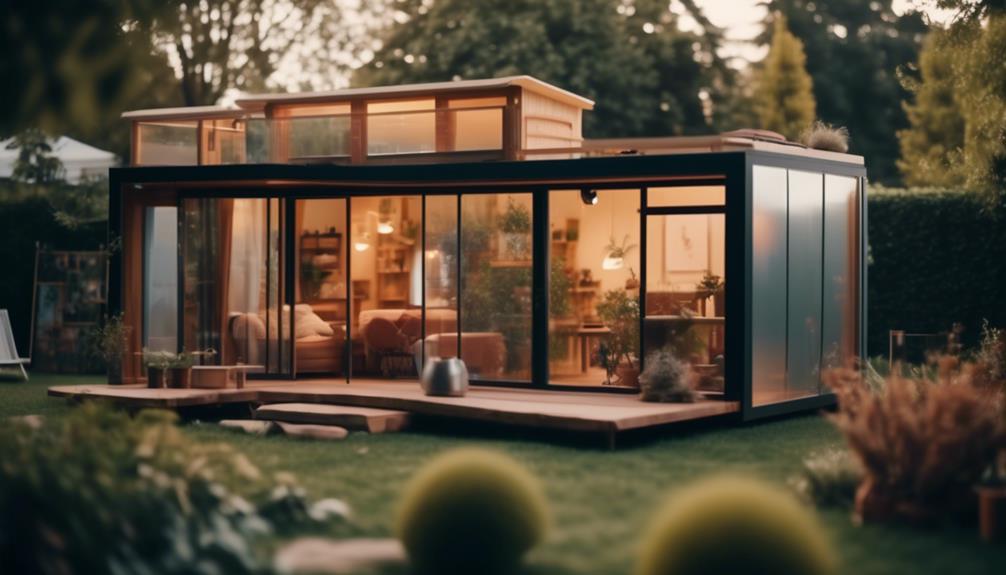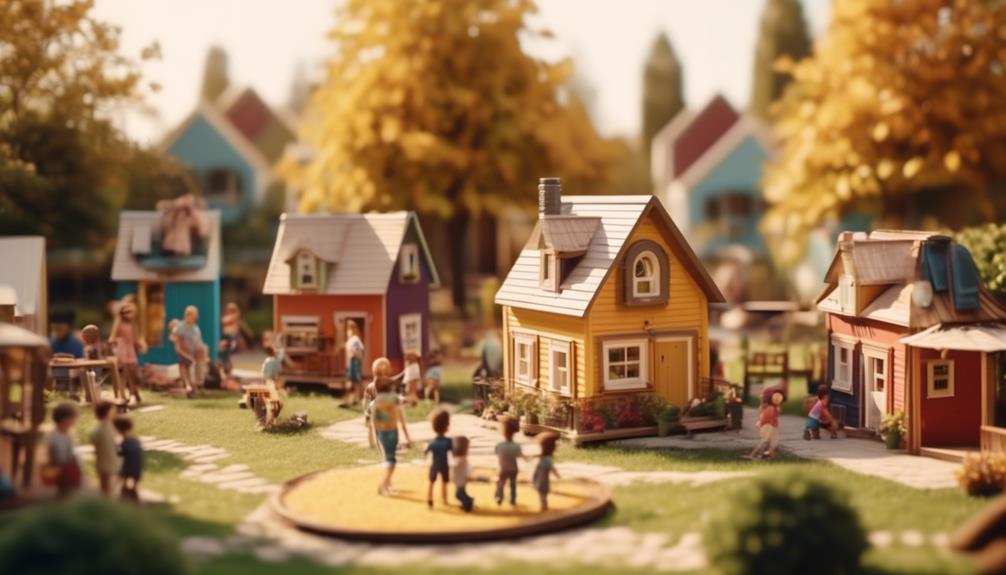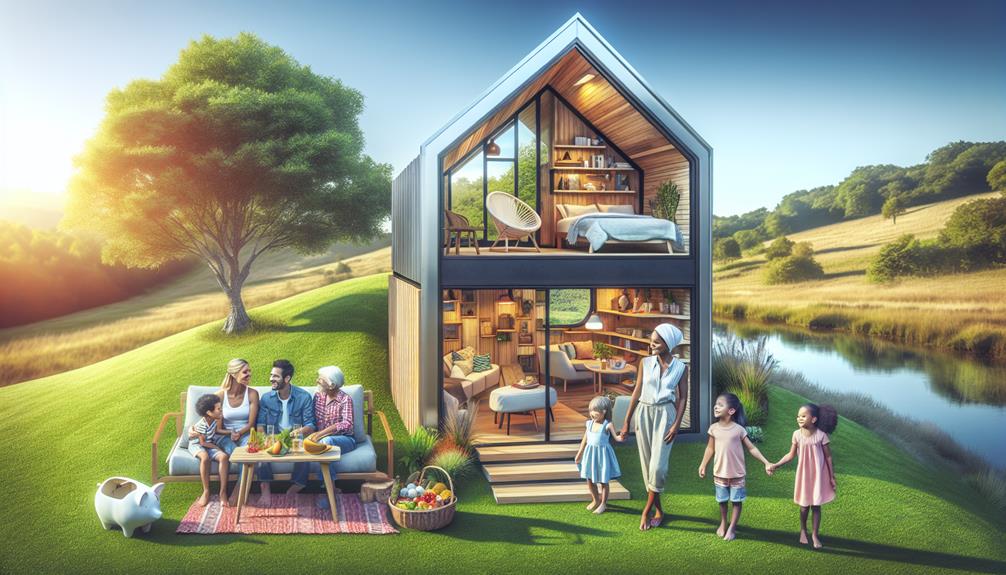As you stand at the threshold of a tiny home, you might wonder if these pint-sized abodes are merely cozy nests for solo birds or if they can also shelter a bustling family flock. You've likely heard the buzz about tiny living—how it promises financial freedom and a lighter ecological footprint—but the question remains whether this innovative lifestyle can truly accommodate the complexities of family life.
Consider the intricate dance of daily routines, the symphony of individual needs, and the harmony that must be struck between communal spaces and private nooks. As you ponder the feasibility of fitting your family's world into a smaller, more intentional footprint, let's explore the realities and adaptations necessary for a family to not just survive, but thrive, within the confines of a tiny home.
Will the sacrifices in space outweigh the gains in simplicity and closeness? Stay with us as we uncover the layers of this modern living conundrum.
Key Takeaways
- Tiny homes can meet the living needs of families by considering sleeping arrangements and daily activities.
- Innovative storage solutions and multifunctional furniture are essential for maximizing living areas in tiny homes.
- Privacy and individuality can be maintained through the use of partitions and personalization of spaces.
- Engaging with the local community and utilizing community resources can enhance the tiny home living experience for families.
Assessing Space Requirements
When considering a tiny home for your family, it's crucial to assess whether the space meets your living needs, from sleeping arrangements to daily activities. With companies like Timbercraft Tiny Homes offering diverse models, you're not limited by square footage. Prioritize innovative storage solutions to maximize living areas, ensuring every inch serves a purpose.
If you have small children, consider models like Le Workshop's Hawkes Bay tiny house, designed with family dynamics in mind. Sleeping lofts can be a game-changer, offering cozy, tucked-away spaces.
Models from Tiny Heirloom and Rocky Mountain Tiny Houses present multi-bedroom options, proving that tiny homes can adapt to your family's size and lifestyle while still embodying the essence of minimalist, functional living.
Designing for Functionality
To make every square inch count, it's essential to prioritize multifunctional furniture and clever storage solutions in your tiny home's design. Embracing the tiny house lifestyle means designing for functionality to ensure your small space meets the dynamic needs of families living in close quarters.
Invest in a sofa that transforms into a bed, merging relaxation with a restful night. Choose fold-away desks or tables that disappear after homework and meals, freeing up precious room. Install wall-mounted shelves and hidden compartments to keep toys and tools out of sight but within reach. Opt for adjustable wall partitions to create private nooks or open gathering areas as needed.
These innovations let you live large within a small footprint, making your tiny home a functional, adaptable, and joyful space.
Balancing Privacy Needs

While embracing multifunctional design is key, it's equally important to create private spaces within your tiny home to ensure every family member feels they've a spot to retreat to.
Innovate with partitions, curtains, or dividers to craft personal zones that offer a sense of ownership and solitude. Encourage children to personalize their nooks, fostering an environment where even in close quarters, individuality thrives.
Open communication and mutual respect among family members are vital in negotiating and respecting boundaries within the shared living space.
Managing Family Dynamics
Navigating family dynamics often requires setting firm boundaries and fostering open dialogue to ensure that everyone's need for personal space is met in a tiny home. Here's a concise guide to help you manage:
- Create nooks for study and play, ensuring young children have a sense of ownership and adults can focus.
- Hold regular family meetings to reinforce the value of time together and shared responsibilities.
- Emphasize respect for each other's space and belongings to maintain peace.
- Approach conflicts with innovative problem-solving, turning challenges into opportunities to grow closer.
Embracing Community Resources

Embrace your local community resources to enhance your tiny home lifestyle with educational, social, and recreational opportunities for the whole family. Dive into the world of tiny living by engaging with community organizations and clubs that offer a platform for social connections. Simplified living doesn't mean you're confined to your small space; it's about branching out and using the broader community as an extension of your home.
| Enrichment | Connection |
|---|---|
| Local Libraries | Community Organizations |
| Community Gardens | Festivals & Events |
| Parks & Recreation | Support Networks |
Take advantage of public transportation and bike-sharing programs to minimize your footprint while exploring the rich tapestry of your surroundings. By doing so, you'll craft unforgettable memories and foster a healthier lifestyle for your family amidst the backdrop of a supportive and vibrant community.
Maximizing Outdoor Living
As you embrace tiny home living, consider crafting a patio that's both stylish and multifunctional, seamlessly blending indoor comfort with the freshness of outdoor spaces.
Turn to vertical gardening to infuse nature into your surroundings without sacrificing precious ground space.
Engage your family with an array of outdoor activities by setting up designated play zones that foster fun and physical movement.
Creative Patio Design
To maximize your patio's potential, consider utilizing vertical space with shelves and hanging plants, alongside multi-functional furniture that offers both comfort and clever storage solutions.
- Transform the compact: Elevate the charm of your tiny house with creative patio designs that turn small living spaces into enchanting retreats.
- Innovate and adapt: Introduce versatile furniture that serves dual purposes, merging functionality with style in your open-air sanctuary.
- Cultivate greenery: Integrate nature into your patio, infusing life into every corner and enhancing the tranquility of your outdoor living area.
- Entertain with ease: Design your space to seamlessly host gatherings, blending the intimacy of tiny houses with the expansiveness of the outdoors.
Embrace the art of maximizing square footage and cherish the endless possibilities your creative patio design brings to outdoor living.
Vertical Gardening Solutions
Discover how vertical gardening can transform your tiny home's outdoor space into a lush, productive oasis without sacrificing precious square footage. By implementing vertical gardening solutions, you're maximizing the utility of every inch. Think trellises brimming with flowering vines or hanging pots with cascading herbs. These not only serve your passion for gardening but also elevate the living experience outside your compact abode.
Vertical planters are particularly adept for tiny homes, allowing you to grow vegetables and flowers in a confined area. You'll be amazed at how much greenery you can nurture upward, creating a living wall that's both functional and beautiful. It's innovation at its finest—extending your living space skyward, ensuring you don't have to compromise on green thumbs because of fewer square feet.
Outdoor Family Activities
Embrace the simplicity of outdoor living in your tiny home, where every family activity becomes an opportunity to connect with nature and each other. Tiny house living encourages you to own less stuff, and in turn, you're free to spend more time on what truly matters.
Delight in the joy of outdoor family activities that not only bring you closer but also foster a sustainable lifestyle.
- Cultivate a garden space that doubles as a living classroom for your kids.
- Create an innovative play area that merges adventure with education.
- Design a cozy, magical nook for storytelling under the stars.
- Integrate functional, multipurpose furniture that transitions from dining to recreation.
In these spaces, you'll find your family's connection to the environment and each other growing stronger every day.
Frequently Asked Questions
Can a Family Live in a Tiny House?
You can live in a tiny house by embracing minimalist lifestyle choices, utilizing space-saving strategies, and navigating zoning challenges. Community living often complements this innovative, functional choice, enhancing your family's cohesion and simplicity.
Can You Have Kids in a Tiny Home?
You can raise kids in a tiny home by mastering space optimization, navigating zoning challenges, perhaps considering mobile schooling, and adapting family dynamics to fit a snug, innovative lifestyle that values function and simplicity.
Can You Permanently Live in a Tiny Home?
You can permanently live in a tiny home by navigating zoning restrictions, embracing community living, tackling legal challenges, and applying innovative downsizing strategies for a functional, cost-effective lifestyle.
Is It Really Cheaper to Live in a Tiny House?
You'll find living in a tiny house often cuts costs through space-saving strategies, lower maintenance expenses, and, occasionally, a surprising resale value. It's a practical, innovative way to save without compromising functionality.
Conclusion
You've weighed the pros and cons, and you're ready to take the leap. Embracing a tiny home isn't just a trend—it's a return to the essentials, a modern-day Renaissance of simplicity.
In your tiny haven, you'll maximize every inch, fostering closeness and cleverly using communal spaces. Outdoor living becomes your expanded playground.
Yes, it's possible for families. With innovation and adaptability, you'll not only manage but thrive, crafting a life rich with experiences over possessions.

